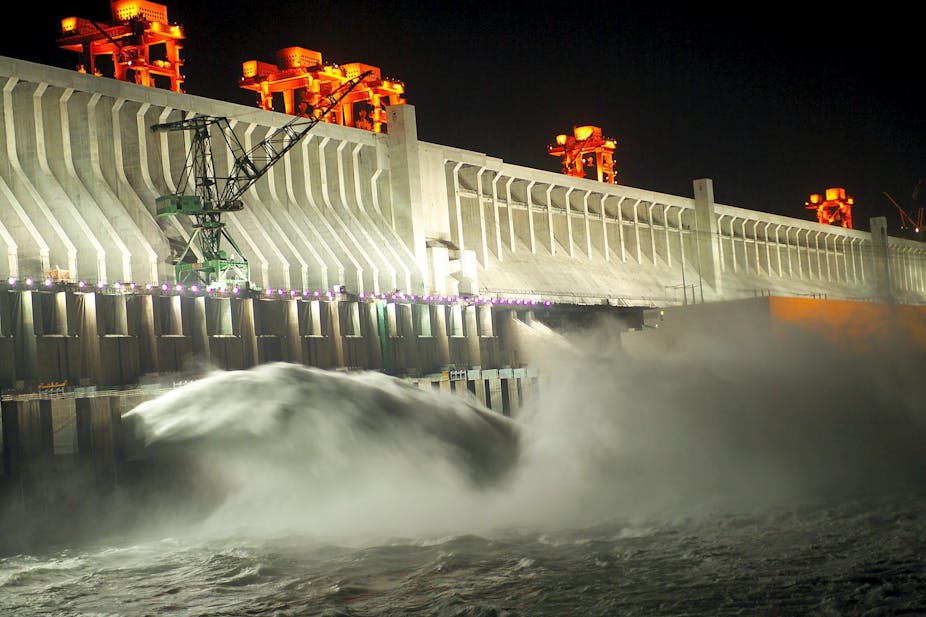Hydroelectricity is an established power-generation technology with over 100 years of commercial operation. Hydroelectricity is produced when moving water rotates a turbine shaft; this movement is converted to electricity with an electrical generator.
According to Euromonitor, hydroelectricity made up 17% of the total world electricity production in 2012. The top four largest electricity producing power stations in the world are all hydroelectric: the Three Gorges in China (18.5 GW), Itaipu in Brazil (14.8 GW), Guri in Venezuela (10.1 GW) and Tucuri in Brazil (8.4 GW).
Australia has more than 100 hydroelectric power stations, with the majority located in New South Wales and Tasmania. The annual production of hydroelectricity in Australia for 2012 was slightly over 6% of the total annual power generation, contributing only 0.4% of the world’s total hydroelectricity production.
The largest hydropower station in Australia is Snowy Mountains Hydroelectric Scheme with a capacity of 3.8 GW, representing almost half of the total hydropower capacity in Australia.
Hydropower technologies
There are three main categories of hydropower technologies: run of river, impoundment, and pumped storage.
The run-of-river technology relies on the flow of the river at an elevated point, which, through gravity, is fed to a turbine generator.
Impoundment hydropower systems employ one or more dams to store water. The potential energy stored in the dam is converted to electricity by passing the stored water from an elevated point through a turbine generator located at the lower point.
Pumped hydropower is a two-dam system, where one dam is installed at a higher point to the other. During off-peak hours when the cost of electricity is low, the water from the lower reservoir is pumped up to the elevated reservoir using electricity from the grid. When the cost of electricity is high during peak hours, the water is released from the upper dam to generate electricity. Pumped hydropower is the only hydropower system that produces a non-renewable form of hydroelectricity.

Hydroelectric limitations
Most of the installed hydropower stations around the world and in Australia are impoundment-based, utilising large reservoirs for storage of water. The electricity generated from these systems is renewable, but is not greenhouse gas neutral.
The hydropower dams are a source of methane, which is 25 times more greenhouse potent than carbon dioxide (CO2).
Methane is formed in the dam when organic matter decays in the absence of oxygen. The organic matter is made up of both the plant material flooded when the dam is initially filled, and plant and soil debris washed into the dam from the banks and upstream. Phytoplankton is also a source of dam emissions in the form of organic matter.
Dams with large seasonal differences in height will produce methane emissions from a continual cycle of growth and decay on the banks when plants grow in summer, only to be flooded again in winter.
The greenhouse gas emissions from hydropower stations are estimated on the basis of CO2 equivalency (CO2e) and they range widely from 5 to as high as 200g CO2e/kWh, with median value of 40g CO2e/kWh. For comparison, coal-fired power stations emit 1000g CO2e/kWh, five times as much as the highest-emitting dams.

Another disadvantage of the hydropower technology is the large areas of land needed to construct large hydropower dams.
It is common for very large hydroelectric facilities to have dams measuring several thousand square kilometers. This poses many environmental and social challenges such as altered ecosystems, the loss of archaeologically and culturally significant sites, and displacement of whole communities. As an example, construction of the Three Gorges Dam in China required the relocation of over 1 million people.
The large surface areas of hydro dams also increase water loss through evaporation. At an average, loss of water from hydroelectric dams is in the range of around 35kg/kWh. This is significant for a dry continent like Australia.
Still a role to play
Despite these limitations, hydropower is the only mature renewable electricity generation technology that is flexible to provide both peak and base load electricity requirements at a cost comparable to coal-produced electricity.
The future of hydroelectricity relies on careful planning to minimise negative impacts to communities, ecosystems and culturally significant sites.
The run-of-river technology is the most environmentally benign method of hydroelectricity production and a greater share of this technology should be given in future energy generation.
The future of the pumped-storage hydropower stations relies on use of intermittent wind and solar energy sources, instead of grid electricity, to pump water between reservoirs.
Decreasing Australia’s close-to-90% coal dependence for electricity generation should be the ultimate goal for future energy technology developments and hydropower still has a role to play.

